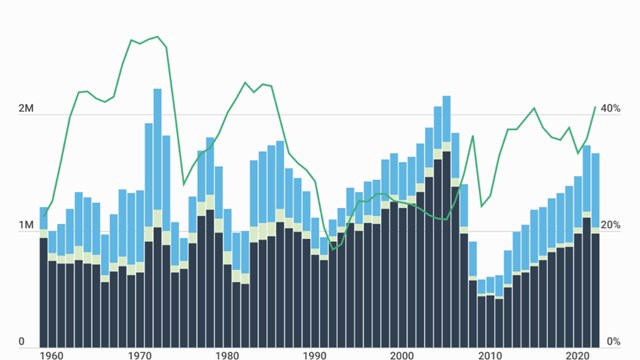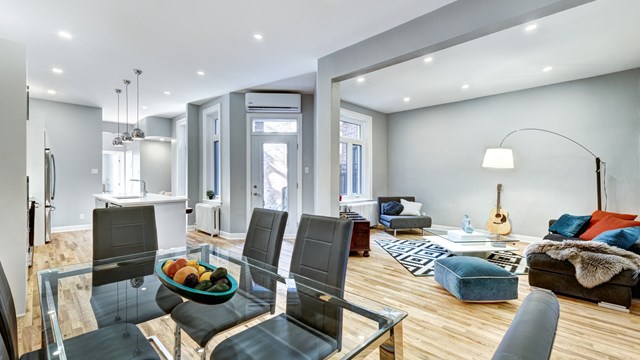Condos and townhouses have continued to be popular real estate choices in New Jersey in 2005, and there is every indication that they will continue their popularity through 2006.
Indeed, condos seem tailor-made for young couples just starting out—as well as older people who have already raised a family and who may not want the responsibility of maintaining an entire house and yard, yet want more security than a rental apartment. That's why condos are selling actively.
As far as co-ops are concerned, however, except for a few urban areas such as Jersey City and Hoboken, they seem to never have taken root in New Jersey the way they did in New York City.
"Co-ops never really caught on New Jersey," says Bill Hanley, manager of Weichert Realtors in Metuchen and president-elect of the New Jersey Association of Realtors (NJAR). "They're something that people are afraid of—they don't understand the idea of shares of stock [in the co-op], they don't understand that they're not real property, they don't understand maintenance fees."
Realtor Carolyn Weiss of RE/MAX Properties Unlimited in Morristown, who advertises as "the condo and townhouse specialist," concurs. Her area in Morris County, she says, once had twin co-ops, but they have since converted to condos. In many parts of New Jersey, co-ops tend to be age-restricted senior communities.
Prices for condos and townhouses have steadily been increasing over the past decade, says Bonnie Fitzgerald, current president of the NJAR and broker/owner of T.F. Byrne & Co., with offices in Brick Township, Lakewood, and Whiting. While she acknowledges a recent leveling-off, she, like other real estate professionals, rejects the popularly held idea of a housing "bubble."
"While we have seen a slight slowdown in our area, I would not say we have a housing bubble, or that the bubble is breaking," she says. "Many factors have contributed to the slight decrease in sales—season or time of year, or more properties on the market for sale that in the past couple of years, for example."
Hanley's take on the bubble issue is that "Real estate is just cyclical—it moves from a buyers' to a sellers' to an even market. Appreciation of real estate changes whether or not people can keep up with it—that's the issue. That's why we have a stabilizing market. In the past, homeowners got such a great appreciation that no one's going to be hurt."
North Jersey Is Active
Which areas are most desirable for homeowners in New Jersey? Among them are those along the shore, the "Gold Coast" along the Hudson River, areas with views of the water in general, and particularly, homes in towns that lie along railroad lines leading to New York City.
In general, the northern area of the state seems more active in terms of real estate than the southern area. According to the NJAR report for the third quarter of 2006 (the latest available at the time of this writing), 49 percent of all home sales in the state were in North Jersey, with the rest divided almost evenly between Central New Jersey and Southern New Jersey, although the report did not break out condos/townhouses as a separate category.
Prices tend to be higher in North Jersey, too. The median sales price in this region of the state during the third quarter, according to NJAR statistics, was $452,600, as opposed to $368,200 in Central New Jersey and $232,900 in Southern New Jersey. Here, too, however, prices reflect single-family homes in general and are not broken down into condos, townhouses or other sub-types.
Looking at their own territories and the state in general, real estate professionals interviewed for this article didn't see any areas that are cooling off.
"All of New Jersey will see appreciation; I don't think anything will go down," says Hanley. Areas that will become hotter, he adds, include the Shore areas, Jersey City, Asbury Park and "anyplace close to Manhattan."
Weiss thinks although the market in general is doing well, suburban areas such as those in her territory "may be a little bit behind the city. I think the suburbs get the overflow from the city." She says that most of the condo construction projects in her area are small projects, buildings with eight or 10 units, although some can have as many as 24.
"I don't see a lot of huge condos going up," she says. "The land is being gobbled up [with other projects]."
What Buyers Are Looking For
What were buyers looking for in terms of amenities, special features or security?
The typical buyer who comes in to look for a home, Hanley says, "has the idea of the four-bedroom house, two-and-a-half bath, two-car garage. They're looking for great rooms, open family spaces. Also more than one full bath."
On the other hand, Weiss of RE/MAX says that from her perspective, "Amenities are not that important to most condo buyers. They could live without a pool [within the condo or townhouse development] —they could use the county or the town pool."
Mortgages and interest rates, of course, also factor into the home-buying process, since they were the lowest in decades, but are now starting to rise a little.
This situation, Weiss believes, has helped keep the real estate market stable. "The people are still out there looking, and mortgage rates are very affordable," she says. "What's becoming more and more difficult to find is a condo/townhouse between $300,000 and $400,000. There's a big demand for them that generally constitutes first-time buyers, at least in this market."
"So far," says Fitzgerald, "the rates are not a factor, and I believe that as long as the rates stay in the single digits, they will not be a factor."
Multiple Listing Services
Multiple Listing Services (MLS) are a very valuable source of information to homebuyers, whether of condos, townhouses, conventional single-family homes or co-ops. With an MLS, brokers work together to list properties for sale. Indeed, the National Association of Realtors' code of ethics mandates that realtors, under normal circumstances, work together with other brokers.
Buyers should know, however, that there's not only one multiple listing service in the state. There are several, and some of them overlap with each other.
For example, the Garden State Multiple Listing Service lists basically the northern half of the state – Bergen, Passaic, Hudson, Essex, Morris, Sussex, Warren, Hunterdon, Somerset, Union and Middlesex counties. Its website (publicstage.gsmls.marketlinx.com/Default.asp) advertises that "currently, there are 22,093 properties advertised for sale in New Jersey."
On the other hand, the New Jersey Multiple Listing Service, according to its website (www.njrealestate.com), concentrates only on Passaic, Hudson, Bergen and Essex Counties, and indeed, it is owned and operated by the Eastern Bergen County Board of Realtors, along with RealSource Association of Realtors. The site, however, does have links to multiple listing services and realty organizations in other parts of the state, such as the Middlesex County MLS and the Ocean County Board of Realtors.
"To my knowledge," says Fitzgerald," there are nine MLS' in the state of New Jersey. Some have reciprocal agreements, but they are all separate and distinct. New Jersey brokers cooperate with each other on a daily basis, and the MLS is a valuable tool to allow for the sharing of data and cooperation between brokers."
No Cooling-Off Seen
According to the NJAR statistics, sales volume rose sharply between last year's first and second quarters, then went down slightly in the third. Still, the experts are optimistic that the state's housing market for condos, co-ops and townhouses will continue to thrive.
"In New Jersey," says Hanley, "we have a large number of people who are coming to her from other states. That will have a great effect on our market."
On the subject of political factors as an influence on the real estate market, Weiss and Fitzgerald don't see it as an issue, even though there's now a new governor, Jon Corzine. However, Hanley says, "The last administration [that of James McGreevey] increased the realty transfer fee. The effect you get is that the seller is forced to pay some of the fees, and this, in turn, can reduce the profit margin.
"As far as the incoming governor, Jon Corzine, is concerned, we [the NJAR] have not spoken to him about specific yet, but we do look forward to talking to him about the housing market," Hanley says. "His lines of communications are open to us."
Corzine's past record as a U.S. senator shows several actions friendly to the real estate industry—for example, in 2002, he signed on as a sponsor to the "Community Choice in Real Estate Act," designed to prevent federally chartered banks from entering the real estate brokerage and property management businesses.
To 2006 and Beyond
Are there any trends that buyers and real estate professionals can look toward in the coming year? Weiss says one that is "Absolutely growing" is having the master bedroom on the first floor, rather than upstairs. Hanley points to different types of mortgage rates being offered to assist buyers in purchasing their new homes.
Regardless of what comes along, he concludes, "The American dream, the dream of property ownership, is something people want. It keeps the economy going."
Raanan Geberer is a freelance writer living in New York City.






Leave a Comment